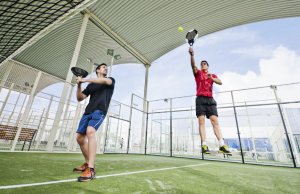The Role of Hydration In Paddle Tennis

Hydration is essential because the human body is comprised of 60 percent water. Throughout the day, you’re losing liquids and that’s why it’s necessary to replenish this percentage. When it comes to paddle tennis, the loss of liquids can be considerable, because it’s a sport that you play outdoors and often in full sun.
In this article, we’ll talk about the role of hydration in sports in general, and for paddle tennis in particular. Keep reading to find out which is the best time to hydrate yourself when you’re doing sports and how much liquid you should drink.
The importance of hydration
Everyone needs to drink liquids throughout the day. Every time you go to the bathroom or sweat, you’re losing liquids and it’s necessary to replace them.
Surely, on more than one occasion, you’ve heard that you should drink two liters of water per day? Actually, this amount is indicative, since it depends on the effort made by the person and their loss of liquids. Besides, there are individuals who can drink water easily and others for whom it’s a real effort.
If you’re one of those people who find it hard to drink water, you can combine it with other liquids; isotonic drinks or natural juices are the best alternatives. However, avoid packaged juices and sodas because otherwise you risk ingesting too much sugar.
The issue of hydration should be taken seriously because not drinking the fluids your body needs can have serious consequences. Some of these are dizziness, heatstroke or even fainting. A great tip is to always carry a water bottle with you, so you can drink during the day.
You must also follow the suggestions that we’ll explain below. Particularly if you practice paddle or another sport with similar physical wear and intensity.

Hydration in paddle tennis
Paddle tennis is one of the sports that require the most hydration. This is because it’s an outdoor activity. During summer, the heat is very intense on the court. On more than one occasion, players have had to abandon a game as a result of dizziness or fainting.
That’s why it’s essential, for both health and performance, to hydrate your body at all times. Below, we’ll explain the guidelines you should follow at all times if you’re playing paddle tennis.
Before training
Before paddle tennis training, you must prepare your body for the effort you’re about to make. This is why it’s necessary to drink at least two glasses of water or, in substitution, the same amount of an isotonic drink. It’s best to drink it within an hour so that you don’t have a heavy stomach when you start exercising.
During training
The amount of water you drink while training will depend on the duration of the training session. As your workout continues, you’ll lose more fluids, so you’ll need to drink more water.
Our recommendation is that you ingest small amounts, just a sip, every time you change your exercise. This way, you won’t feel heavy, and you’ll be compensating for the loss of fluids.
Besides, the idea that drinking water during exercise produces gas is a myth. This fact is not proven.
After training
If you have followed the two previous steps, dehydration will be moderate at the end of training. It’s time to replace the fluids you’ve lost.
As you’ve already made the effort, you can begin to hydrate yourself with water or isotonic drinks. Try drinking a delicious natural juice, at the same time that you relax and let your body rest.
In short, paddle tennis training is one of the many physical activities that, in addition to demanding a lot of effort, requires the replacement of lost liquids and minerals. For your own well-being, always remember to stay hydrated.
Hydration is essential because the human body is comprised of 60 percent water. Throughout the day, you’re losing liquids and that’s why it’s necessary to replenish this percentage. When it comes to paddle tennis, the loss of liquids can be considerable, because it’s a sport that you play outdoors and often in full sun.
In this article, we’ll talk about the role of hydration in sports in general, and for paddle tennis in particular. Keep reading to find out which is the best time to hydrate yourself when you’re doing sports and how much liquid you should drink.
The importance of hydration
Everyone needs to drink liquids throughout the day. Every time you go to the bathroom or sweat, you’re losing liquids and it’s necessary to replace them.
Surely, on more than one occasion, you’ve heard that you should drink two liters of water per day? Actually, this amount is indicative, since it depends on the effort made by the person and their loss of liquids. Besides, there are individuals who can drink water easily and others for whom it’s a real effort.
If you’re one of those people who find it hard to drink water, you can combine it with other liquids; isotonic drinks or natural juices are the best alternatives. However, avoid packaged juices and sodas because otherwise you risk ingesting too much sugar.
The issue of hydration should be taken seriously because not drinking the fluids your body needs can have serious consequences. Some of these are dizziness, heatstroke or even fainting. A great tip is to always carry a water bottle with you, so you can drink during the day.
You must also follow the suggestions that we’ll explain below. Particularly if you practice paddle or another sport with similar physical wear and intensity.

Hydration in paddle tennis
Paddle tennis is one of the sports that require the most hydration. This is because it’s an outdoor activity. During summer, the heat is very intense on the court. On more than one occasion, players have had to abandon a game as a result of dizziness or fainting.
That’s why it’s essential, for both health and performance, to hydrate your body at all times. Below, we’ll explain the guidelines you should follow at all times if you’re playing paddle tennis.
Before training
Before paddle tennis training, you must prepare your body for the effort you’re about to make. This is why it’s necessary to drink at least two glasses of water or, in substitution, the same amount of an isotonic drink. It’s best to drink it within an hour so that you don’t have a heavy stomach when you start exercising.
During training
The amount of water you drink while training will depend on the duration of the training session. As your workout continues, you’ll lose more fluids, so you’ll need to drink more water.
Our recommendation is that you ingest small amounts, just a sip, every time you change your exercise. This way, you won’t feel heavy, and you’ll be compensating for the loss of fluids.
Besides, the idea that drinking water during exercise produces gas is a myth. This fact is not proven.
After training
If you have followed the two previous steps, dehydration will be moderate at the end of training. It’s time to replace the fluids you’ve lost.
As you’ve already made the effort, you can begin to hydrate yourself with water or isotonic drinks. Try drinking a delicious natural juice, at the same time that you relax and let your body rest.
In short, paddle tennis training is one of the many physical activities that, in addition to demanding a lot of effort, requires the replacement of lost liquids and minerals. For your own well-being, always remember to stay hydrated.
All cited sources were thoroughly reviewed by our team to ensure their quality, reliability, currency, and validity. The bibliography of this article was considered reliable and of academic or scientific accuracy.
- Palacios, N., Montalvo, Z., & Ribas, A. M. (2009). Alimentación, nutrición e hidratación en el deporte. Consejo Superior de Deportes (Vol. 165, p. 26). https://doi.org/10.1016/j.jad.2014.04.038
This text is provided for informational purposes only and does not replace consultation with a professional. If in doubt, consult your specialist.








